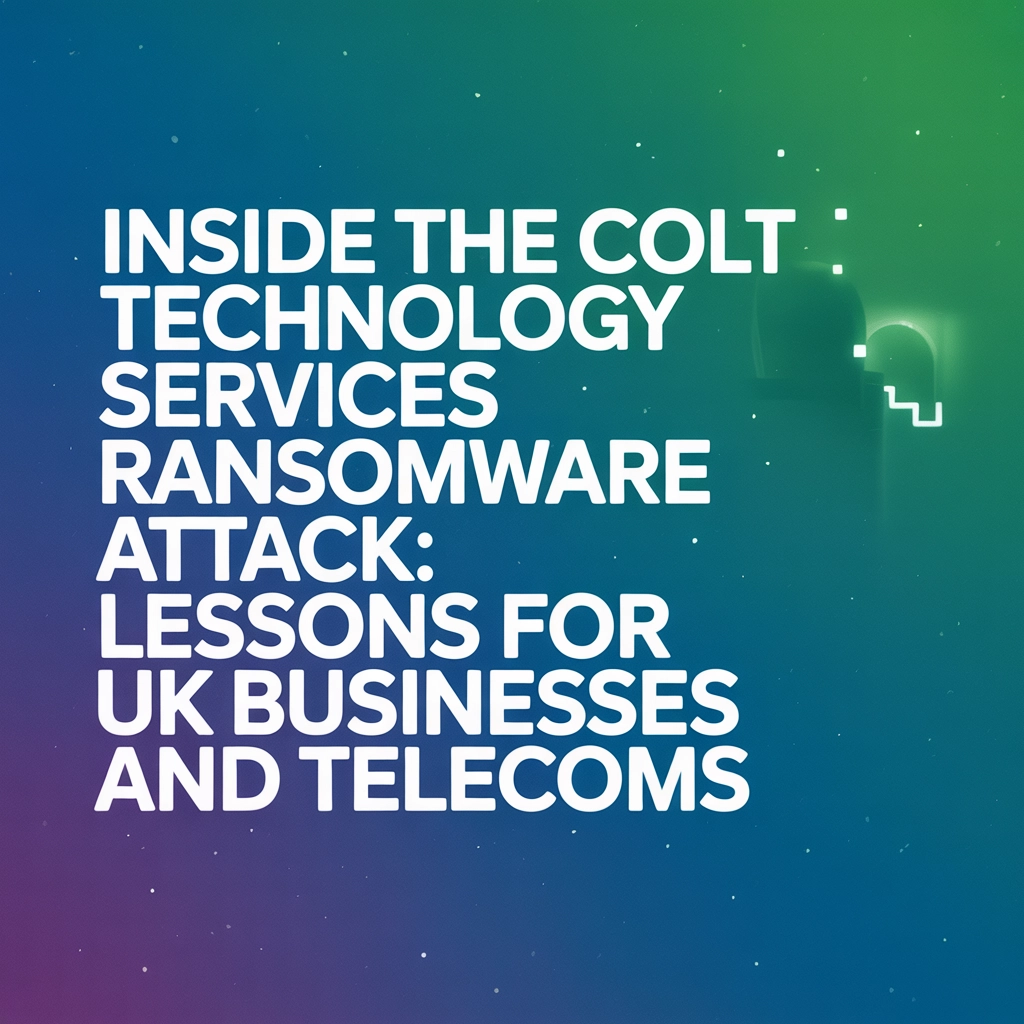The ransomware attack on Colt Technology Services in August 2025 has spread anxiety throughout the UK technology and telecom sector. As cyber incidents increase in frequency and impact, this event stands out for the scale of disruption, the sensitivity of data exposed, and the modern tactics employed by attackers. Businesses across the sector are rightly asking: What happened? Could it happen to us? And how do we build resilience in the face of a growing threat landscape?
Ransomware Strikes: Timeline and Immediate Impact
On 12 August 2025, Colt Technology Services, a UK telecommunications powerhouse operating in thirty countries, detected a major cyber incident on its internal systems. Although initially described as a “technical issue,” the severity quickly became clear. Support systems, including the Colt Online customer portal, hosting and porting services, and Voice API platforms, were taken offline as a precaution, disrupting client access and communications for several days.
The WarLock ransomware group soon claimed responsibility, boasting of having exfiltrated more than a million sensitive documents and setting a $200,000 ransom for their return. This incident targeted an internal system, yet still had extensive knock-on effects for customer-facing infrastructure and business continuity.

How the Attack Happened: A SharePoint Exploit
Security investigations by both internal teams and third-party experts pointed to a likely exploitation of a Microsoft SharePoint vulnerability, CVE-2025-53770. This security flaw allows unauthorised actors to extract cryptographic keys, enabling them to execute malicious code and gain persistent access to enterprise environments. Reports indicated that WarLock gained initial access through unpatched public-facing SharePoint servers, an object lesson in the risk of delayed security updates.
The technical compromise went far beyond the classic “encrypt and demand ransom” playbook. Attackers methodically exfiltrated hundreds of gigabytes of data, including personnel records, customer contracts, financial documents, network architecture plans, and internal communications. To bolster their demands and prove authenticity, the group even published a sample of around 400,000 files on underground forums, which security experts have since confirmed as genuine.
A Modern Ransomware Economy
The WarLock attack illustrates a rapidly evolving ransomware economy. Attackers combined traditional ransom demands with data extortion, offering stolen files for sale on Russian cybercrime marketplaces. Their claims were not empty: financial records, employee salary information, and even executive personal data went up for grabs, all priced at $200,000.
This “double extortion” model, encrypting operational systems while monetising stolen data, has become standard among advanced ransomware actors. WarLock’s professionalism, marketplaces usage, and commercial attitude highlight the mature business strategies of today’s cybercriminals. For UK telecom and SaaS companies holding sensitive data, this marks a new and dangerous frontier.
Fallout: Service Disruption and Trust Erosion
Colt’s response, taking systems offline and isolating compromised segments, likely prevented deeper penetration. Nonetheless, the business suffered significant disruption. Customer inquiries were forced onto slower, less efficient channels. Key support APIs and portals remained unavailable for an extended period, shaking both customer confidence and partner trust.
Despite the company’s assurance that core network infrastructure was unaffected, the operational impact was significant. As a critical telecom provider serving global enterprises, disruptions at Colt rippled across supply chains, underlining the broader risks posed by supply-chain cyber attacks and interconnected business services.

Lessons for UK Enterprises: Building Better Resilience
1. Patch Management is Non-Negotiable
The Colt breach is a stark reminder: unpatched vulnerabilities remain the number one vector for major attacks. Even established and well-defended businesses are vulnerable if security updates are delayed on public-facing applications. A zero-tolerance approach to patch management is no longer optional—it is a board-level imperative.
Learn more about patching and penetration testing in our overview: Why Do You Need a Pentest?
2. Segmentation Helps, But Is Not Enough
Colt’s infrastructure segmentation did mitigate some damage, but the attack demonstrated that operational disruption is possible even without a direct breach of front-line systems. Security strategies must go beyond segmentation to include continuous monitoring, aggressive containment playbooks, and regular simulation of breach scenarios.
3. Swift Incident Response Pays Off
Taking affected systems offline undoubtedly inconvenienced users, but it likely spared Colt further business and reputational harm. Having a tested, well-practised incident response plan—and the will to act decisively when trouble strikes, can be the difference between a contained incident and a multi-million-pound catastrophe.
4. Transparent, Timely Communication
Colt’s initial messaging as a “technical issue” was quickly overtaken by the reality of a ransomware attack. In today’s regulatory and media environment, clarity and speed in communicating cyber incidents are essential for retaining customer trust and minimising speculation.
5. The Sector Must Expect Sustained Targeting
This incident follows high-profile attacks on other major telecoms, including Orange and Bouygues. Why the focus on this sector? Telecoms sit at the heart of digital economies, manage vast information flows, and provide infrastructure for businesses and governments alike. For ransomware groups, a successful attack promises both huge payouts and considerable leverage.

Supply Chain and Regulatory Risks
The incident is also a sharp reminder of how quickly supply chain risks can escalate. With partners, resellers, and downstream customers all potentially exposed, even limited intrusions in a provider’s operations can amplify dramatically. This underlines the necessity for rigorous third-party risk management and transparency across shared platforms.
On the compliance front, Colt’s notification to authorities in accordance with UK law could herald further scrutiny from regulators, especially if customer or employee data has been exposed. GDPR, industry-specific guidance, and cyber incident disclosure rules all raise the stakes, increasing direct and indirect costs associated with such breaches.
The WarLock Group: Trend Indicator for 2025
WarLock, while a newer player, has rapidly built a reputation for technical skill and business acumen within the cyber underground. Their willingness to exploit zero-day vulnerabilities, blend classic and emerging extortion techniques, and professionally broker stolen data makes them a prime indicator of the sophistication now found among ransomware groups targeting UK and European enterprises.
This event raises a red flag: businesses can expect more persistent, better-organised and well-resourced attacks in the months ahead.
The Role of EJN Labs in Modern Cyber Defence
At EJN Labs, we see attacks like the one on Colt as both a call to action and an opportunity to empower our clients. Our approach combines rapid, AI-driven penetration testing, continuous threat intelligence, and compliance-first advisory services to help organisations close gaps before the worst can happen. We specialise in:
- Automated, deep-dive pentesting and patch management reviews
- AI-based detection of emerging threats and attack patterns
- Telecom and SaaS security consultancy, including incident simulation drills
- Supply chain cyber risk assessments and partner ecosystem mapping
Do not wait for an attack to discover your weaknesses. Find out how our services can strengthen your resilience: EJN Labs Cyber Security Services

Final Thoughts: The Path Forward for UK Telecom and Beyond
The Colt Technology Services ransomware attack is not just another cyber incident; it is a warning shot to the entire UK telecom and digital services supply chain. Business leaders, security professionals, and regulators alike must take heed, because attackers are adapting, and the cost of complacency is rising fast.
Prioritise patch management, incident response readiness, supply chain mapping, and proactive security validation. Partner with trusted cybersecurity specialists who can help you anticipate, withstand, and rebound from even the most complex modern attacks.
For further reading and expert updates, see:
- BleepingComputer – Colt Telecom attack claimed by WarLock ransomware, data up for sale
- ComputerWeekly – WarLock claims ransomware attack on network services firm Colt
- CSO Online – UK’s Colt hit by cyberattack, support systems offline amid ransom threat
- Infosecurity Magazine – Colt Customers Face Prolonged Outages After Major Cyber Incident
- ITPro – UK telecoms firm takes systems offline after cyber attack












Leave a Reply